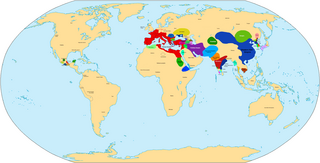A proleptic calendar is a calendar that is applied to dates before its introduction. Examples include:
A proleptic calendar is a calendar that is applied to dates before its introduction. Examples include:

AD 1 (I), 1 AD or 1 CE is the epoch year for the Anno Domini calendar era. It was the first year of the Common Era (CE), of the 1st millennium and of the 1st century. It was a common year starting on Saturday or Sunday, a common year starting on Saturday by the proleptic Julian calendar, and a common year starting on Monday by the proleptic Gregorian calendar. In its time, year 1 was known as the Year of the Consulship of Caesar and Paullus, named after Roman consuls Gaius Caesar and Lucius Aemilius Paullus, and less frequently, as year 754 AUC within the Roman Empire. The denomination "AD 1" for this year has been in consistent use since the mid-medieval period when the anno Domini (AD) calendar era became the prevalent method in Europe for naming years. It was the beginning of the Christian/Common era. The preceding year is 1 BC; there is no year 0 in this numbering scheme. The Anno Domini dating system was devised in AD 525 by Dionysius Exiguus.
AD 3 (III) or 3 AD was a common year starting on Monday or Tuesday of the Julian calendar and a common year starting on Monday of the Proleptic Julian calendar. At the time it was known as the Year of the Consulship of Lamia and Servilius. The denomination "AD 3" for this year has been used since the early medieval period when the Anno Domini calendar era became the prevalent method in Europe for naming years.
The proleptic Julian calendar is produced by extending the Julian calendar backwards to dates preceding AD 8 when the quadrennial leap year stabilized. The leap years that were actually observed between the implementation of the Julian calendar in 45 BC and AD 8 were erratic: see the Julian calendar article for details.
Year 1 BC was a common year starting on Friday or Saturday in the Julian calendar and a leap year starting on Thursday in the Proleptic Julian calendar. It is also a leap year starting on Saturday in the Proleptic Gregorian calendar. At the time, it was known as the Year of the Consulship of Lentulus and Piso. The denomination 1 BC for this year has been used since the early medieval period when the Anno Domini calendar era became the prevalent method in Europe for naming years. The following year is 1 AD in the widely used Julian calendar, which does not have a "year zero".
Year 3 BC was a common year starting on Wednesday or Thursday of the Julian calendar and a common year starting on Tuesday of the Proleptic Julian calendar. At the time, it was known as the Year of the Consulship of Lentulus and Messalla. The denomination 3 BC for this year has been used since the early medieval period, when the Anno Domini calendar era became the prevalent method in Europe for naming years.
Year 8 BC was either a common year starting on Friday or Saturday or a leap year starting on Thursday of the Julian calendar and a common year starting on Wednesday of the Proleptic Julian calendar. At the time, it was known as the Year of the Consulship of Censorinus and Gaius Asinius. The denomination 8 BC for this year has been used since the early medieval period, when the Anno Domini calendar era became the prevalent method in Europe for naming years.
Year 9 BC was either a common year starting on Wednesday, Thursday or Friday or a leap year starting on Thursday of the Julian calendar and a leap year starting on Monday of the Proleptic Julian calendar. At the time, it was known as the Year of the Consulship of Drusus and Crispinus. The denomination 9 BC for this year has been used since the early medieval period, when the Anno Domini calendar era became the prevalent method in Europe for naming years.
Year 10 BC was either a common year starting on Tuesday, Wednesday or Thursday or a leap year starting on Tuesday or Wednesday of the Julian calendar and a common year starting on Sunday of the Proleptic Julian calendar. At the time, it was known as the Year of the Consulship of Maximus and Antonius. The denomination 10 BC for this year has been used since the early medieval period, when the Anno Domini calendar era became the prevalent method in Europe for naming years.

Year 11 BC was either a common year starting on Monday or Tuesday or a leap year starting on Sunday, Monday or Tuesday of the Julian calendar and a common year starting on Saturday of the Proleptic Julian calendar. At the time, it was known as the Year of the Consulship of Tubero and Maximus. The denomination 11 BC for this year has been used since the early medieval period, when the Anno Domini calendar era became the prevalent method in Europe for naming years.
Year 24 BC was either a common year starting on Thursday, Friday or Saturday or a leap year starting on Friday of the Julian calendar and a common year starting on Thursday of the Proleptic Julian calendar. At the time, it was known as the Year of the Consulship of Augustus and Flaccus. The denomination 24 BC for this year has been used since the early medieval period, when the Anno Domini calendar era became the prevalent method in Europe for naming years.
Year 21 BC was either a common year starting on Monday, Tuesday or Wednesday or a leap year starting on Tuesday of the Julian calendar and a leap year starting on Sunday of the Proleptic Julian calendar. At the time, it was known as the Year of the Consulship of Lollius and Lepidus. The denomination 21 BC for this year has been used since the early medieval period, when the Anno Domini calendar era became the prevalent method in Europe for naming years.

Year 16 BC was either a common year starting on Monday, Tuesday or Wednesday or a leap year starting on Monday or Tuesday of the Julian calendar and a common year starting on Sunday of the Proleptic Julian calendar. At the time, it was known as the Year of the Consulship of Ahenobarbus and Scipio. The denomination 16 BC for this year has been used since the early medieval period, when the Anno Domini calendar era became the prevalent method in Europe for naming years.
Year 22 BC was either a common year starting on Sunday, Monday or Tuesday or a leap year starting on Sunday or Saturday of the Julian calendar and a common year starting on Saturday of the Proleptic Julian calendar. At the time, it was known as the Year of the Consulship of Marcellus and Arruntius. The denomination 22 BC for this year has been used since the early medieval period, when the Anno Domini calendar era became the prevalent method in Europe for naming years.

Year 17 BCE was either a common year starting on Sunday or Monday or a leap year starting on Saturday, Sunday or Monday of the Julian calendar and a leap year starting on Friday of the Proleptic Julian calendar. At the time, it was known as the Year of the Consulship of Furnius and Silanus. The denomination 17 BC for this year has been used since the early medieval period, when the Anno Domini calendar era became the prevalent method in Europe for naming years.
Year 18 BC was either a common year starting on Friday, Saturday or Sunday or a leap year starting on Saturday of the Julian calendar and a common year starting on Thursday of the Proleptic Julian calendar. At the time, it was known as the Year of the Consulship of Lentulus and Lentulus. The denomination 18 BC for this year has been used since the early medieval period, when the Anno Domini calendar era became the prevalent method in Europe for naming years.
Julian Day may refer to:
The Symmetry454 calendar (Sym454) is a proposal for calendar reform created by Irv Bromberg of the University of Toronto, Canada. It is a perennial solar calendar that conserves the traditional month pattern and 7-day week, has symmetrical equal quarters in 82% of the years in its 293-year cycle, and starts every month on Monday.
Proleptic is the foreshadowing, or anticipation, of future events may refer to:
The proleptic Gregorian calendar is produced by extending the Gregorian calendar backward to the dates preceding its official introduction in 1582. In nations that adopted the Gregorian calendar after its official and first introduction, dates occurring in the interim period of 15 October 1582 to the date on which the pertinent nation adopted the Gregorian calendar and abandoned the Julian calendar are sometimes 'Gregorianized' also. For example, the birthday of President George Washington was originally dated 11 February 1731 because Great Britain, of which he was born a subject, used the Julian calendar and dated the beginning of English years as 25 March. After Great Britain switched to the Gregorian calendar, Washington's birthday was dated 22 February 1732 proleptically, according to the Gregorian calendar applied backward. This remains the modern dating of his birthday.

The tables below list equivalent dates in the Julian and Gregorian calendars. Years are given in astronomical year numbering.